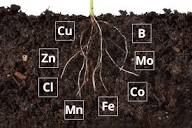Boron and iron are micronutrients because they are needed by plants in minute quantities. However, their deficiency in the soil and plant systems affects the productivity of crops. In this article, readers will learn about the factors that affect the ability of the soil to supply boron (B) and iron (Fe).
Boron Dynamics in Soil and Plant Nutrition
1. Boron Sources and Deficiency Symptoms in Crops
Boron is a light non-metal occurring in soil as borosilicate; an example is tourmaline, the main boron-containing mineral in soil. Its deficiency has been reported in legumes, root crops, and fruit crops.
Deficiency symptoms include the breakdown of internal tissue of roots, death of terminal buds, brittle leaves, shortened internodes resulting in abnormally short plants, and older leaves becoming chlorotic (B is immobile; hence, younger parts are affected first).
Read Also: Causes of Diseases in Farm Animals and How to Prevent Disease OutBreak
2. Functions of Boron in Plant Growth

Boron is responsible for the transportation of sugars and for terminal bud growth. It is also responsible for enzyme activation.
3. Factors Influencing Boron Availability in Soils
i. Organic matter content: High organic matter increases boron availability.
ii. Clay content (texture): Heavy soils contain more boron than light soils (sandy soils).
iii. Soil pH: Boron availability drops at pH levels >6.5.
iv. Soil moisture: Boron availability decreases under dry soil conditions.
Read Also: Cutworms: How to Identify and Get Rid of Cutworms
Iron Dynamics in Soil and Plant Nutrition

1. Iron Sources and Deficiency Symptoms in Crops
Although the total amount in the earth’s crust is high, this is not related to its availability. Iron is required by some enzyme systems and cytochromes. It is associated with chloroplast proteins.
Deficiency has always been associated with high pH, high CaCO₃, or both. Iron is immobile; therefore, symptoms of chlorosis and stunted growth are first noticed on upper, younger leaves.
In the soil system, iron occurs in the following minerals:
- Fe₂O₃ (Hematite)
- Fe₃O₄ (Magnetite)
- FeCO₃ (Ferrous carbonate)
- Fe₂(SO₄)₃ (Iron pyrite)
- Fe₂O₃·3H₂O (Limonite).
Iron also occurs in primary minerals such as biotite, chlorites, olivine, and other ferromagnesian minerals.
2. Factors Affecting Iron Availability in Soils
i. Soil pH: Iron availability reduces with increasing pH.
ii. Ratio of Fe:Mn (negative interaction/antagonism): Increasing Mn levels cause iron deficiency.
iii. High concentration of P may cause iron chlorosis, as iron is fixed by P.
iv. Excess HCO₃⁻ (bicarbonate): This reduces iron availability.
v. Free CaCO₃ also reduces iron availability.
vi. High levels of Zn, Cu, and Mn.
vii. High soil moisture and poor aeration.
Availability of soil boron and iron is dependent on soil factors such as pH, clay types, soil moisture, and organic matter.
Boron and iron are important micronutrients in the soil.
Do you have any questions, suggestions, or contributions? If so, please feel free to use the comment box below to share your thoughts. We also encourage you to kindly share this information with others who might benefit from it. Since we can’t reach everyone at once, we truly appreciate your help in spreading the word. Thank you so much for your support and for sharing!

